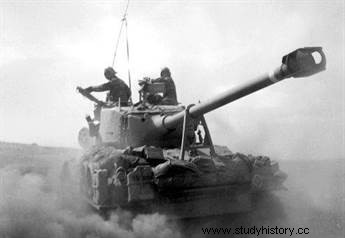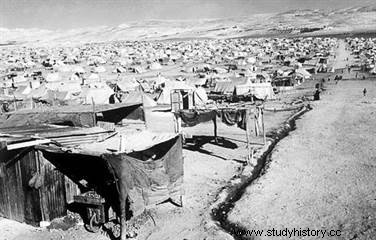 The Six-Day War (June 1967) is the third armed conflict that has pitted Israel against neighboring Arab countries:Egypt, Jordan and Syria. It began on June 5, 1967 with an Israeli air raid followed by a general offensive under the leadership of Moshe Dayan. The IDF tanks advanced rapidly and on June 10, when the clashes ceased, Israel controlled the entire Sinai Peninsula, the Gaza Strip, the West Bank, the eastern part of Jerusalem and the strategic site of the Golan Heights in Syria. But, poisoned tributes, these "occupied territories" soon became an explosive hotbed of tension in the region.
The Six-Day War (June 1967) is the third armed conflict that has pitted Israel against neighboring Arab countries:Egypt, Jordan and Syria. It began on June 5, 1967 with an Israeli air raid followed by a general offensive under the leadership of Moshe Dayan. The IDF tanks advanced rapidly and on June 10, when the clashes ceased, Israel controlled the entire Sinai Peninsula, the Gaza Strip, the West Bank, the eastern part of Jerusalem and the strategic site of the Golan Heights in Syria. But, poisoned tributes, these "occupied territories" soon became an explosive hotbed of tension in the region.
Israel, a country surrounded
 Following the 1956 conflict, during which Israel opposed Nasser's Egypt in coordination with the Franco-British, the Arab powers intend to take their revenge on Tel-Aviv. This revenge became a serious possibility, when in 1966 Egypt and Syria signed a military alliance, clearly directed against Israel.
Following the 1956 conflict, during which Israel opposed Nasser's Egypt in coordination with the Franco-British, the Arab powers intend to take their revenge on Tel-Aviv. This revenge became a serious possibility, when in 1966 Egypt and Syria signed a military alliance, clearly directed against Israel.
The Jewish state was then surrounded by hostile nations, whose rearmament was facilitated by the Soviet Union. The tension rose a notch when in April 1967, an air battle saw Israelis and Syrians clash over the Golan Heights. The outcome is clearly unfavorable to Damascus, which provokes a wave of indignation in the Arab world. For its part, Egypt obtains the withdrawal of United Nations (UN) troops stationed in the Sinai and Gaza since 1957. Nasser then decides to remilitarize the Sinai and mass powerful mechanical formations on the southern borders of Israel. . On the 23rd, Egypt begins a blockade of the port of Eilat and the Strait of Tiran, preventing oil supplies from Israel.
Seven days later, King Hussein of Jordan reluctantly joined the Syrian-Egyptian alliance. Faced with a possible war on three fronts (West Bank in the center, Sinai in the south, Golan in the north), the government of Levi Eshkol believes that it is urgent to take the lead, the economy starting to suffer from the Egyptian blockade. After securing the tacit and unofficial support of the United States mired in Vietnam, it was decided to take action. On June 1, Moshe Dayan, a war hero is appointed Minister of Defense...
The Six Day War
Four days later the Israeli offensive begins with a powerful preventive attack against the Egyptian air force. It loses nearly 80% of its devices in one day. The sky will then be Israeli, which will greatly facilitate operations on the Tel Aviv side. Having control of the air, Israel, under the impetus of the Israeli Minister of Defense, General Moshe Dayan, then launched a general offensive. Israeli tanks, commanded by General Yitzhak Rabin, seized the Gaza Strip on the 6th.
 As of June 7, Tsahal seizes Sharm-El-Sheikh and approaches the Suez Canal the next day . On the 8th, almost all of Sinai is under Israeli control. The Egyptian formations everywhere overwhelmed, have literally been swept away... In the north the Syrians have no other choice but to abandon the Golan Heights, which Tsahal conquers with a hard struggle. Finally in the center, the Jordanian army which counted on an Egyptian victory, recognizes its defeat in barely two days.
As of June 7, Tsahal seizes Sharm-El-Sheikh and approaches the Suez Canal the next day . On the 8th, almost all of Sinai is under Israeli control. The Egyptian formations everywhere overwhelmed, have literally been swept away... In the north the Syrians have no other choice but to abandon the Golan Heights, which Tsahal conquers with a hard struggle. Finally in the center, the Jordanian army which counted on an Egyptian victory, recognizes its defeat in barely two days.
A lightning victory with serious consequences
The war ends on June 10, with an Israeli-Syrian ceasefire. The human losses are also heavy for the Arab countries:20,000 dead for Egypt, 6,000 for Jordan and 500 for Syria. For losses of about 700 men, the Israeli army seized Sinai, the Gaza Strip, the Golan Heights, the West Bank and East Jerusalem. The consequences of this conflict will be lasting and profound. Around 350,000 Palestinians are fleeing these territories, whose occupation is condemned by UN Security Council Resolution 242.
 Nasserian pan-Arabism has just taken a blow from which it will never recover, which will not be for nothing in the rise of Islamist movements. As for the Israelis, they will have to face the challenge of occupied territories populated by Palestinians. Soon, a certain Yasser Arafat will embody in the eyes of the world the cause of this stateless people...
Nasserian pan-Arabism has just taken a blow from which it will never recover, which will not be for nothing in the rise of Islamist movements. As for the Israelis, they will have to face the challenge of occupied territories populated by Palestinians. Soon, a certain Yasser Arafat will embody in the eyes of the world the cause of this stateless people...
Bibliography on the 6 Day War
- By Pierre RAZOUX, Six Day War, June 5-10, 1967:from myth to reality. Economica, 2006
- By Raphaël DELPARD, The Six-Day War:Victory and Poison. Souny, 2007.
